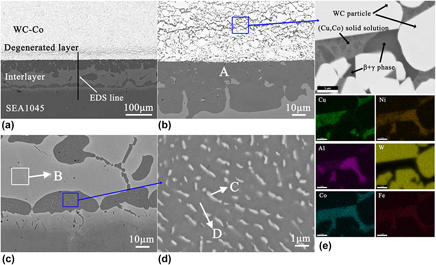Article contents
Wetting and brazing of Ni-coated WC–8Co cemented carbide using the Cu–19Ni–5Al alloy as the filler metal: Microstructural evolution and joint mechanical properties
Published online by Cambridge University Press: 08 May 2018
Abstract

The wetting of Cu–19Ni–5Al alloy on Ni-coated WC–8Co substrates with different coating thicknesses was investigated, and the brazing of Ni-coated WC–8Co to SAE1045 steel was performed by using the Cu–19Ni–5Al alloy as the filler metal. All the Cu–19Ni–5Al/Ni-coated WC–8Co systems present excellent wettability with a final contact angle of ∼10°. The thicknesses of the β + γ phase enriched with Co, Ni, and Al at the two joint interfaces increase and decrease with the Ni coating thickness, brazing temperature, and holding time increasing, respectively. The joint shear strength increases first and then decreases with the increase of Ni coating thickness, brazing temperature, or holding time. The maximum joint shear strength of ∼328 MPa is obtained while Ni plating for 90 min and brazing at 1210 °C × 5 min.
Keywords
- Type
- Article
- Information
- Copyright
- Copyright © Materials Research Society 2018
References
REFERENCES
- 6
- Cited by





